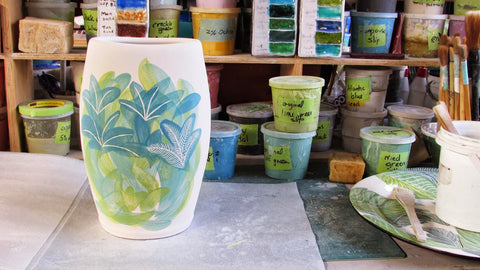
One of the differences between what we do and how an individual studio potter may approach their work, is that during the design process thought has to be given to how someone other than the designer will be able to execute the design - our decorating team. This is not easy as decision making in the early stages is often an intuitive response to what you see unfolding before your eyes, an unconscious drawing on previous work and what you know of the materials.
Our creative process is also a little unusual in that it is very much like a game of ping-pong, with the two of us (with widely different skills and experience) flicking work back and forth, playing with an idea until we spot something that works aesthetically, looks practical and importantly fits with the overall development of our range. It's not just a matter of coming up with something new, it has to be an addition that compliments and extends what we already have, and anticipates latent demand. People often don't know what they want until they see it, and our job is to get there first! It is also tempting to respond to a new insight whilst in the middle of working on something. We try to avoid that, pausing to document an emerging idea, and then finishing the original work as planned. A second piece can then be made incorporating the new insight.

The value of this is that the two things can be compared, and any changes can be seen for what they are...an improvement, a distraction or a backward step. It's a truism, but less is often more, and knowing when to stop adding to a design is a hard won design skill, something that is really only achieved with experience. Of course we don't stick to this religiously, but it is a useful guiding principle. We also like to tackle work thematically, in other words looking at a particular set of specific problems. In the work illustrated here, we are endeavoring to find a 'softer' palette, a more delicate glaze treatment that will off-set the bigger, bolder, brighter work that characterizes a bulk of the range.


The intent here is to create a loose, water colour under wash with slips that will provide a complex background of subtle coloured toning that then can be counter pointed with scratched detail. This has to be done reasonably quickly, but the sum of the parts has to be greater than the whole! Complex simplicity!
- Nick C


